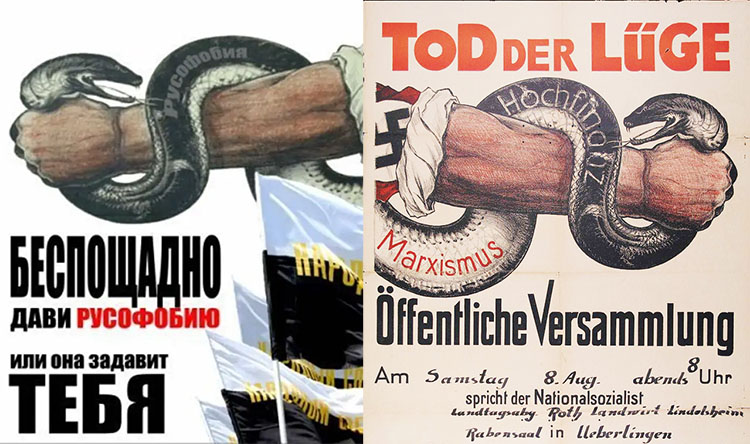A poster about “anti-Russian research structures” featuring a version of a Nazi propaganda picture was hung in St. Petersburg’s police station #70, RFE/RL’s Russian desk reports. A photo of the document was published by the Russian media outlet Fontanka.
The poster was prepared by the Personnel Department of the Main Directorate of the Ministry of Internal Affairs of the Russian Federation for St. Petersburg and the Leningrad Region. It is dedicated to foreign research organizations. It says that foreign think tanks train people who “at the right time will be able to become the instigators of massive anti-government protests,” conduct anti-Russian activities, and “in fact are analogous” to special services.
The poster features a drawing of a man’s hand crushing a snake labeled “Russophobia” with the caption “Strangle Russophobia mercilessly or it will strangle you!”. This is a mirrored version of the 1931 Nazi drawing “Death of Lies” (Tod der Lüge), which, according to the Baden-Württemberg Archives website, was used on a billboard for an event of the National Socialist German Workers’ Party (NSDAP).
In the Nazi original, the man’s shirt bears a red band with a swastika, and on the snake has the inscriptions “Marxism” and “Big Capital,” the latter being an antisemitic conspiracy theory the Nazis used to come to power.

However, the imagery of a man’s hand crushing a snake was used by the USSR, as well. It is seen in a poster from 1937, at the height of Stalin’s repressions, instructing to uproot “spies and saboteurs… Troskyist-Bukharin agents of fascism.”
Therefore, the police poster’s visual was conjured 90 years ago. But the concept of Russophobia goes further back into history. According to the Polish experts Jolanta Darczewska, Piotr Żochowski of Warsaw’s Centre for Eastern Studies, “Russophobia” is a Russian imperial construct of the 19th century, created to deflect western criticism of the tsars’ expansionism.
The authors note that its reinstatement as a core meme of Russian propaganda “represents the declaration of another stage of Russia’s communications war with the Kremlin’s opponents, both foreign and domestic.”
According to the experts, the concept of “Russopobia” is strategic meme akin to a “weapon of mass destruction,” as it allows silencing internal opposition to the Kremlin’s policies, legitimizing the regime, neutralizing foreign critics, and offering a simplistic explanation for the Russia’s tensions with the West simultaneously.
Kremlin’s campaign against “Russophobia” threatens both Russia and the West, Polish experts say
Among purported Russophobic organizations, the poster in the St. Petersburg police station names the following organizations:
“As of 2020, organizations who most actively conduct activities against the Russian Federation can be divided into:
1) Those promoting Russophobia: the Kennan Institute, Chatham House;
2) Those conducting destructive activities: The Soros Fund;
-The National Endowment for Democracy;
-The Yegor Gaidar Fund;
-USAID;
-The MacArthur Foundation.
3) Human Rights organizations:
-Human Rights Watch;
-Amnesty International;
-Memorial.”
The latter on this list refers to the Memorial Society, one of Russia’s most reputable human rights organizations documenting the plight of modern-day political prisoners as well as exposing Communist repressions, was declared a “foreign agent” in 2013 and fined millions of rubles. Its activists in various regions of Russia have been prosecuted.








